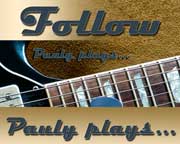9th chords
A 9th chord is built by adding the 2 note of the scale to the dominant 7th chord. If the 7th is not included it is called an "add9". Dominant chords are built using the Mixolydian Mode, which just means that it is a standard major scale with a flatted seventh note.
These chords can work very well as a basis for blues lead patterns. Take a look at the dominant ninth arpeggios page to see the patterns and what else they relate to.
In the charts below there are a few options for which notes to play depending on your experience and ability to stretch. Play the small notes every time. The large notes are to root, which are there for reference. You can try to add the root, as long as it does not block another note.
The same chords and patterns are shown in both a vertical and a horizontal display because some people have trouble with one form or the other.
This page requires javascript.
This page will not work on old browsers. (It is all done with the HTML5 canvas elements and JavaScript. Making it work on old browsers would require double the work, so no thanks.)
C form
The C form.
A form
The A form. Don't play the root note on the 2nd string but try to play the third on in. If you can't play either then it technically isn't a 9th chord, but there are times it will be good enough.
G form
Typically only strings two through five are played, but the root can be added on one and six if you can manage it.
E form
One of the easier forms to play. It's a regular barred E7 with a 9th added on the high E string.
D form
Another form where you may end up playing the chord without the 3rd, so it wouldn't technically be a 9th. Often it is played by barring fret 1 and playing the root instead of the required 3rd.
Using the patterns
All of the chords in the CAGED system can be barred, at least to some degree. So somewhere on the neck there is a place to play each of the 5 forms as various inversions of the chord. In other words, there are at least 5 ways to play an E chord.
Use these patterns to play a lead pattern wherever you happen to be on the neck. For instance, if you're playing an E chord as a barred A (starting on the 7th fret), then play the A form lead over it.


